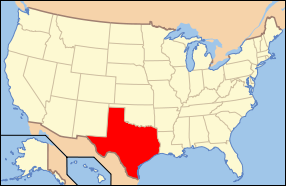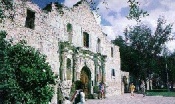Difference between revisions of "Directory:Texas"
| Line 3: | Line 3: | ||
| Fullname = State of Texas | | Fullname = State of Texas | ||
| Flag = Texas flag.png | | Flag = Texas flag.png | ||
| − | | Flaglink = | + | | Flaglink = [[Flag of Texas]] |
| Seal = Texas seal.png | | Seal = Texas seal.png | ||
| Map = Texas map.png | | Map = Texas map.png | ||
Revision as of 02:33, 7 February 2007
| |||||||
| Capital | Austin | ||||||
| Largest city | Houston | ||||||
| Area | Ranked 2nd | ||||||
| - Total | 268,581 sq mi (695,622 km²) | ||||||
| - Latitude | 25°50'N to 36°30'N | ||||||
| - Longitude | 93°31'W to 106°38'W | ||||||
| Population | Ranked 2nd | ||||||
| - Total (United States Census 2000) | 20,851,820 | ||||||
| - Density | 79.6/sq mi 31/km² (28th) | ||||||
| Admission to Union | December 29, 1845 (28th) | ||||||
| Governor | Rick Perry (R) | ||||||
| U.S. Senators | Kay Bailey Hutchison (R), John Cornyn (R) | ||||||
| Time zones | |||||||
| - most of state | Central: UTC-6/-5 | ||||||
| - tip of West Texas | Mountain: UTC-7/-6 | ||||||
Texas is a state of the south-central United States. It was admitted as the 28th state in 1845. Explored by the Spanish in the 16th and 17th centuries, the region became a province of Mexico in the early 19th century. Texans won their independence in 1836 after a gallant but losing stand at the Alamo in February and a defeat of Santa Anna's forces at the Battle of San Jacinto (April 21). Denied admission as a state by antislavery forces in the U.S. Congress, the leaders of Texas formed an independent republic that lasted until 1845. Austin is the capital and Houston the largest city.
<adsense> google_ad_client = "pub-5512298628457000"; google_ad_width = 728; google_ad_height = 15; google_ad_format = "728x15_0ads_al"; google_ad_channel = ""; google_color_border = "FFFFFF"; google_color_bg = "FFFFFF"; google_color_link = "0066CC"; google_color_text = "000000"; google_color_url = "008000"; </adsense>
History
Spanish Exploration and Colonization
The region that is now Texas was early known to the Spanish, who were, however, slow to settle there. Cabeza de Vaca, shipwrecked off the coast in 1528, wandered through the area in the 1530s, and Coronado probably crossed the northwest section in 1541. De Soto died before reaching Texas, but his men continued west, crossing the Red River in 1542. The first Spanish settlement was made (1682) at Ysleta on the site of present day El Paso by refugees from the area that is now New Mexico after the Pueblo revolt of 1680. Several missions were established in the area; but the Comanche, Apache, and other Native American tribes resented their encroachment, and the settlements did not flourish.
A French expedition led by La Salle penetrated E Texas in 1685 after failing to locate the mouth of the Mississippi. This incursion, though brief, stirred the Spanish to establish missions to hold the area. The first mission, founded in 1690 near the Neches, was named Francisco de los Tejas after the so-called tejas [friends]: Native Americans. This is also the origin of the state's name. In general, however, Spanish attempts to gain wealth from the wild region and to convert the indigenous population were unsuccessful, and in most places occupation was desultory.
American Expeditions and Settlement
By the early 19th cent. Americans were covetously eyeing Texas, especially after the Louisiana Purchase (1803) had extended the U.S. border to that fertile wilderness. Attempts to f

